Contents
- History of breeding
- Description of the Buckingham Taiberry variety
- Characteristic of Ejemaline Buckingham Tyberry
- Advantages and disadvantages of the variety
- Planting Buckingham Tyberry
- Caring for Buckingham Tyberry
- Reproduction of Buckingham Tayberry raspberries
- Conclusion
- Reviews of gardeners about Buckingham Tyberry hemmalin
A hybrid of raspberries and blackberries has a number of characteristics that are attractive to gardeners. Due to the decorative bushes, productivity, taste of berries, plants are becoming increasingly popular. One of the most famous varieties is Buckingham Tayberry.
History of breeding
A hybrid of blackberries and raspberries was obtained by chance back in the late 19th century. When growing two different bushes side by side, cross-pollination occurred, as a result of which the blackberry appeared.
In 1962, the Englishman D. Jennings, known as the first breeder who received large-fruited raspberries, created the Tayberry variety of blackberry. It is based on blackberry Aurora (Rubus caesius Aurora) and raspberry Malling Jewel (Rubus idaeus Malling Jewel). After 20 years of continuous work in Scotland, along with others, a new Buckingham Tayberry blackberry hybrid (Rubus hybrid Buckingham Tayberry) was obtained, which is distinguished by thornlessness and other significant advantages.

Buckingham Tyberry became available to gardeners only at the end of the 20th century.
Description of the Buckingham Taiberry variety
Ezhemalina Scottish selection is close in its characteristics to the Tayberry variety, which inherited the best of the traits from its predecessors. From blackberries got a high regular yield, unpretentiousness, and from raspberries – the taste of berries and their aroma.
Bush appearance
Buckingham Tayberry Ezhemalina forms a tall, powerful bush. Creeping shoots are very flexible, their length is up to 2,5 m. There are no thorns on the elastic stems. The foliage is dark green, the edges of the plates are serrated. The flowers are large, pale pink.
Description and taste of berries
Buckingham Tayberry’s Ezhemalina begins to bear fruit two years after planting. Its berries are large, each has a length of about 5 cm and a weight of up to 15 g. They are collected in brushes, consisting of 6-8 fruits of an elongated, conical shape. At the beginning of ripening they have a bright red color, later they darken and become burgundy with a typical blackberry sheen. The taste is sweet and sour, the aroma is raspberry-caramel, strong. You can pick from a branch only with a stalk. Berries are distinguished by a high content of vitamin C. They are used for culinary purposes for the preparation of jams, marmalades, compotes. The fruits of Buckingham Tayberry raspberries perfectly retain their beneficial properties when frozen. Transportability is average.
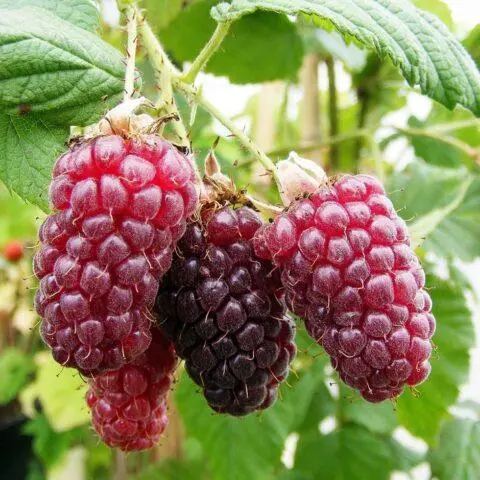
The use of berries helps to reduce the level of bad cholesterol in the blood
Characteristic of Ejemaline Buckingham Tyberry
Ezhemalina refers to unpretentious berry bushes. It does not require special conditions for growing, but with proper care, the yield increases significantly.
Flowering period, ripening period and yield
The fruiting of the Buckingham Tayberry raspberry occurs on the shoots of the second year. The plant is self-fertile. Large pink buds open in the first decade of May. Flowering lasts about a month, after which the first berries begin to ripen from the end of June. Fruiting is uniform, powerful, lasts about a month. The berries are prone to baking, because they are constantly in the sun, they are not covered by foliage. With an untimely collection of Buckingham Tayberry raspberries, it quickly ripens and crumbles.
The average yield from a bush that is at least four years old is 5 kg. Subject to agricultural technology, successful wintering and careful care, it can be increased to 7-8 kg per plant. The average yield of Buckingham Tayberry raspberry when grown on an industrial scale is 29 tons per hectare.
Frost resistance
The berry shrub inherited high frost resistance from the blackberry. The Buckingham Taiberry variety can be grown even in Siberian conditions. It is not as resistant to low temperatures as other raspberry varieties and requires shelter for the winter. This is not difficult to do, since the shoots of the plant are very plastic, they can easily be bent to the soil.
Disease and pest resistance
The hybrid of raspberry and blackberry has high immunity, but during the period of adverse weather conditions (cold snap, prolonged rains) it can be attacked by insect pests and develop diseases.
High humidity contributes to the appearance of a white coating on the foliage, deformation of the berries, fragility of the stems. These are the first signs of powdery mildew, a fungal disease that copper-based preparations are used to combat.
Rust manifests itself in the form of brown spots, which gradually increase in size, the foliage turns yellow and dries out. Brown cankers also appear on the stems.
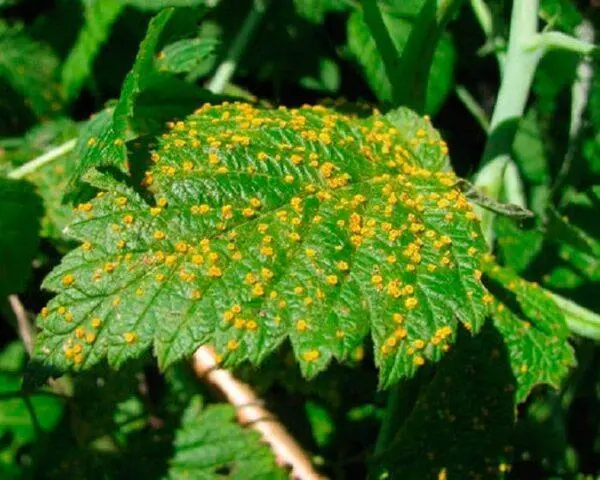
Plants affected by rust are removed and burned, and the soil is disinfected.
Verticillium wilt of the foliage of Buckingham Tayberry raspberries begins with yellowing of the green mass, and ends with its complete fall. For the purpose of prevention, multiple treatments with Bordeaux liquid are used.
Among insect pests, gall midges and the raspberry beetle are the most dangerous to the plant. The former lay their eggs under the bark, which ends with the death of the plants, the latter eats out the buds of the Buckingham Tayberry raspberry and significantly reduces the expected yield.
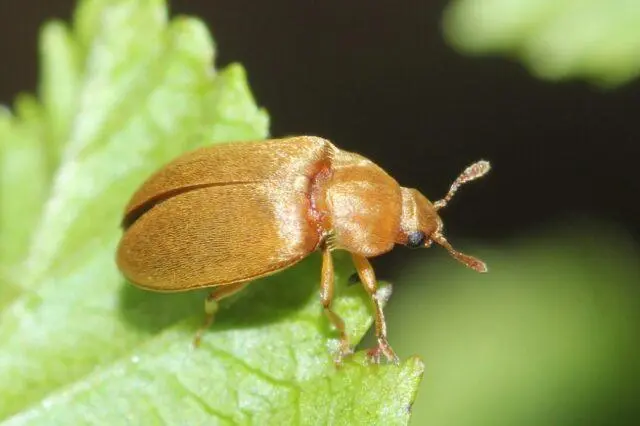
As a preventive measure against raspberry beetle, digging of the soil is carried out in autumn
No less harm to unblown flowers is caused by the weevil, which lays its eggs there, and the larvae developing in them do not allow the buds to open. Insecticides are used to control pests during their activation.
Advantages and disadvantages of the variety
Buckingham Tayberry’s ezhemalina has not yet become as widespread as many of the raspberry and blackberry varieties. But every year more and more gardeners choose a berry bush.
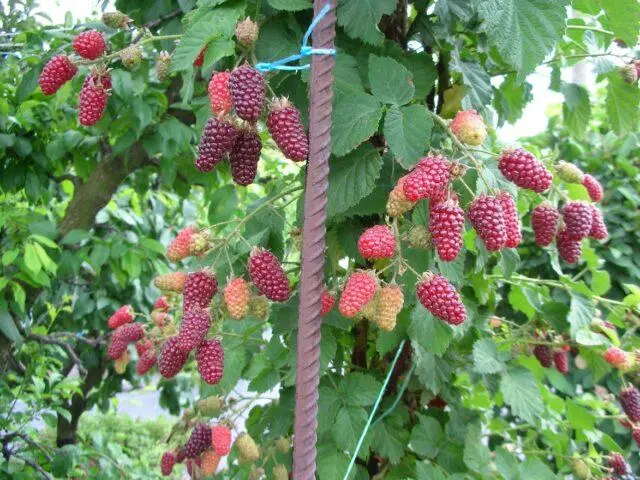
In the summer, the Buckingham Tyberry hybrid tolerates a lack of moisture perfectly.
Among the advantages of the variety:
- unpretentiousness in care;
- undemanding to growing conditions;
- early ripening;
- high stable yield;
- good quality berries;
- resistance to diseases and pests;
- self-fertility of culture;
- decorative bushes.
Cons of Buckingham Tyberry raspberries:
- the need for shelter for the winter;
- low transportability;
- short shelf life fresh;
- tendency to bake in the sun;
- the need for thinning bushes due to rapid growth.
Planting Buckingham Tyberry
You can plant raspberries in April, when the snow melts and the soil warms up, or in autumn, just before the first frost. If necessary, you can do a transplant in the summer, if you keep the root system of the plant as much as possible along with the earthy clod.
Sandy or loamy soils rich in organic matter are best suited for Buckingham Tayberry raspberries. Do not plant bushes in low-lying wetlands with a high occurrence of groundwater. Light partial shade will avoid baking berries under the sun. Yemalina feels good on the southern and southeastern slopes, protected from the northern winds. One-year-old seedlings are selected that have at least three live buds at the base of the stem and moist, elastic roots with no signs of decay.
When planting Buckingham Tayberry raspberries, they act according to the algorithm:
- The soil is dug up, weeds and debris are removed.
- Sand and peat are added if the soil is heavy.
- Add humus, compost, ash.
- Make a tape furrow 50 cm wide and 50 cm deep.
- Make rotted compost, superphosphate and potassium sulfate.
- Seedlings are placed at intervals of 50 cm, between rows – 2 m.
- Sprinkle the roots, lightly tamp the soil.
- Watered.
- Mulch with peat, sawdust or straw.
- The top is cut off, leaving 30 cm of the stem.
When planted in bushes, Buckingham Tayberry raspberries make separate pits for plants measuring 40 cm x 40 cm x 40 cm.
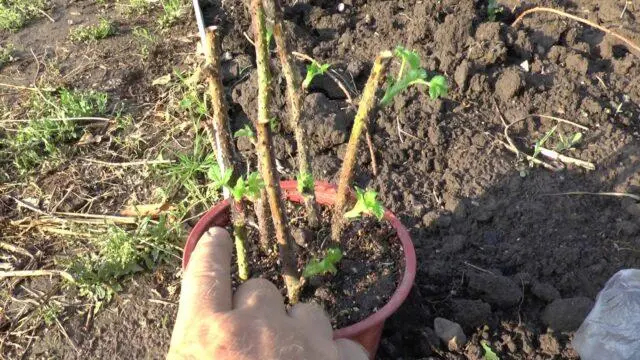
Buckingham Tayberry Ezhemalin grows well on soil with neutral acidity.
Caring for Buckingham Tyberry
The berry bush is unpretentious and does not need daily care. Once every ten days, every raspberry is watered abundantly. If the summer is hot and dry, irrigation is carried out twice as often as usual. Immediately after the end of the harvest, fruiting branches are cut out, those whose length is more than 2 m are shortened, and broken and diseased ones are removed.
To prevent Buckingham Tayberry from starting to “fatten”, top dressing is applied no more than once every three years. The best option is to add 5 kg of humus and compost to the soil for each bush in combination with 20 g of nitrophoska and a glass of wood ash.
Before the onset of winter, shortened shoots are tied into bunches, bent to the ground, covered with boards, covered with dry foliage and non-woven material.
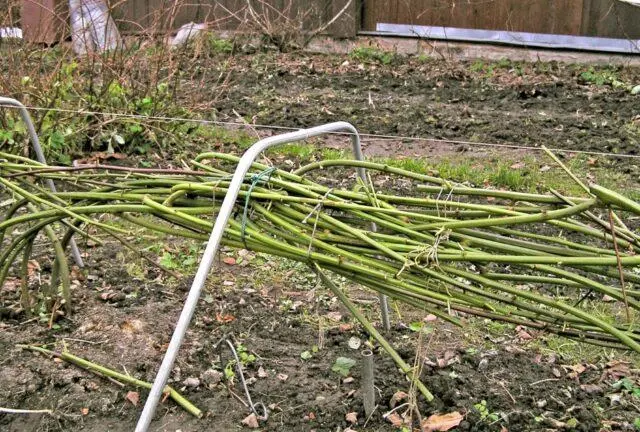
Shelter allows you to save plants at a temperature of -35 ⁰С
Reproduction of Buckingham Tayberry raspberries
To obtain new raspberry plants, several methods of reproduction are used:
- Layering – they tilt and lay the shoot in the prepared trench, cover it with soil, and tie the top to the support. After rooting, they are separated from the mother bush and transplanted.
- Rhizome – a bush is dug up, cut into pieces and delenki are planted.
- Cuttings – they are harvested in the summer, treated with a growth stimulator and rooted in a greenhouse.
Conclusion
Ezhemalina Buckingham Tyberry is ideal for the garden. It is unpretentious, productive, the berries have excellent taste. With a small amount of time spent on care, you can have tasty and healthy fruits on the table for a month.









